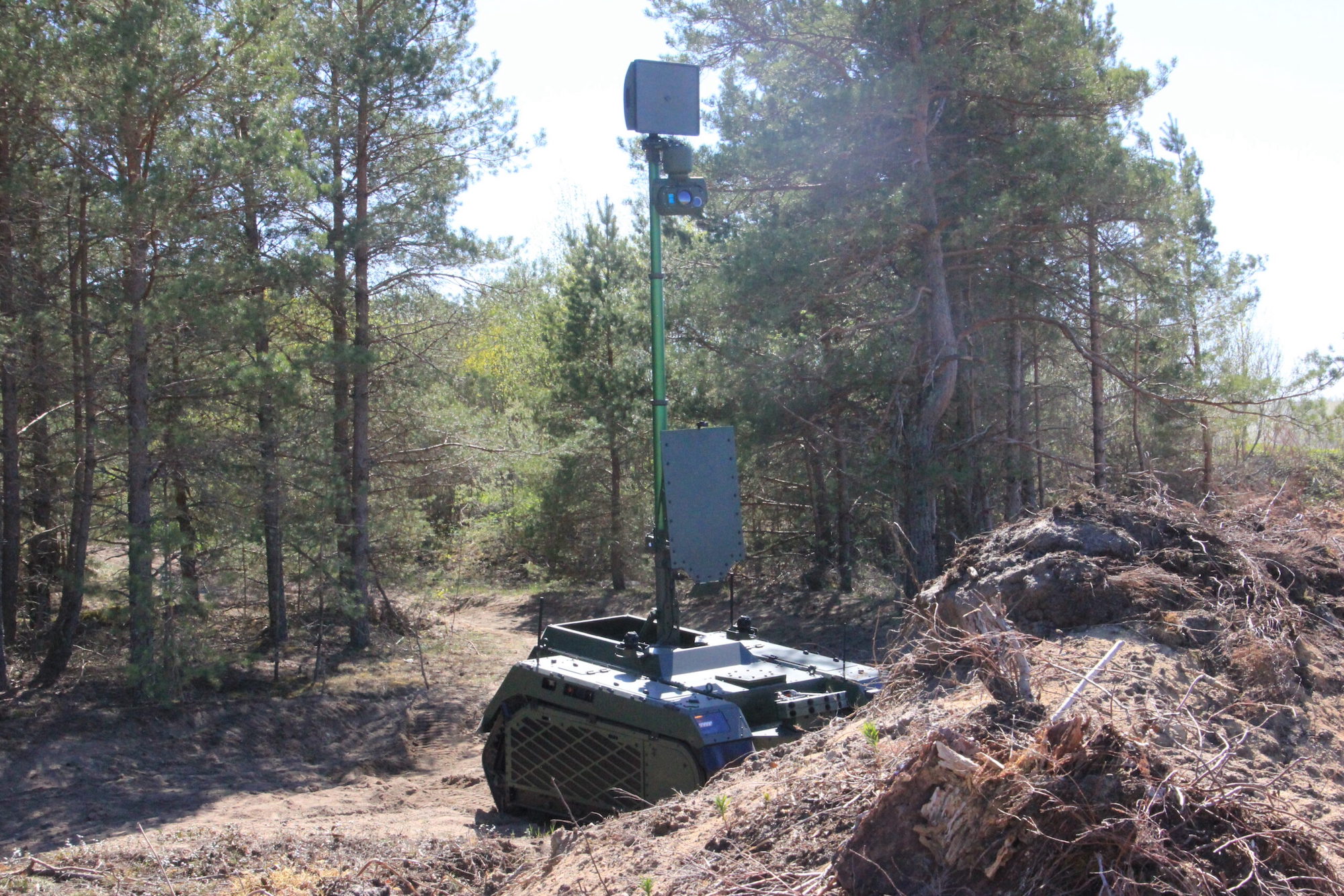

On June 2, at an army base in the forested interior of Belgium, a team of robots tentatively advanced through a mock battlefield. On treads and wheels, and alongside uniformed soldiers, these robots scouted buildings, took defensive positions behind packed earth bulwarks, and some even donned camo netting, hiding their bulky frame from casual view. An armed ground robot tucked into an outcropping of trees, its turret pointed to guard the advance. This training exercise, the fourth such demonstration of the robots by the Belgian Army, was part of the European iMUGS project, or integrated Modular Unmanned Ground System.
The exercise centered on a vehicle called THeMIS, made by Estonia’s Milrem Robotics, the company that was the lead coordinator for the 32.6 million euro (roughly $35 million) project. Alongside Estonia’s Milrem, companies in France, Finland, Spain, Germany, Latvia, and Belgium contributed to the project, with the goal of developing a “modular and scalable architecture” that could be easily modified for use alongside human-carrying vehicles. In short, the exercise was a way for soldiers to test out using many robots at once.
By designing robots as part of a broader architecture, the project allows the robot-making companies and robot-using militaries to think about how these tools will work alongside existing traditional vehicles and in combination with one another. The goals of the project include developing both air and ground vehicles, control systems, a way for the vehicles to communicate with each other and human operators, sensors to perceive the world and share that info in a useful way, space for weapons, and computer software that facilitates smooth and useful operation by algorithm.
Crucial to these efforts is making sure that any robot potentially fielded can be subject to human command. When the project was launched in December 2020, Milrem announced that “The system to be developed will be under meaningful human control.”
[Related: The UK’s wee military recon drones will double as cartographers]
THeMIS, already established as a versatile platform that can carry a host of payloads, became the centerpiece of the project. The basic version is a tracked vehicle about the length of a small golf cart, though wider and shorter. It can be remotely controlled a mile away from a human operator, and on a diesel-electric engine it can drive for up to 15 hours. As a versatile wagon, it can carry gear, like backpacks, fuel, or extra rations, while keeping up with a marching army or driving ahead at just over 12 mph.
What makes the THeMIS crucial as a platform for militaries to explore using battlefield robotics is the way it can carry other sensors and perform tasks beyond just mobile cargo haulers. A range of turrets can be mounted on it, so the THeMIS can host cameras, rangefinders, and weapons from machine guns to anti-tank missiles like the Javelin to loitering munitions. These weapons are remote-controlled, though targeting algorithms can assist in finding and tracking vehicles or people before a human operator presses the trigger.
Beyond weapons, the THeMIS can also support sensors to survey the battlefield, and one such system was debuted in the June 2 exercise in Belgium. THeMIS Observe, as the tower-deploying variant was called, features a camera, a radar, an acoustic sensor to detect gunfire, as well as a “Rapid Obscuring System” made by Rheinmetall dubbed ROSY. This device can, in a second, blast smoke, heat, and light that makes it hard for infrared, optical, and laser sensors to see a vehicle abruptly hidden.
[Related: This laser-armed Stryker vehicle can shoot down drones and mortar rounds]
By putting all these sensors on a deployable tower on a battlefield robot, soldiers in the field can gain more information than previously available at their level. To make the task of managing a robot while surviving in combat a little easier, the bot can autonomously follow another vehicle or follow waypoints plotted on a map. Obstacle detection and avoidance helps keep the vehicle from collision.
Alongside the THeMIS robots in the exercise were at least five minimalist ground robots bearing the logo of dotOcean, an autonomous control company that focuses on retrofitting existing boats with new control systems. Their contribution to the modular ground robot project is developing an algorithm that lets a fleet of networked robots collaborate together.
In a video of the exercise, Summit-XL robots from Spain’s Robotnik company also appear. These wheeled machines can be remotely driven or operate autonomously, and use lasers and other sensors to scan and survey surrounding terrain.
Taken as a whole, the robots in the exercise support soldiers by scanning the battlefield in ways human eyes can’t. The exercise, at least as shown on video, supported a future where smaller wheeled robots on roads could identify new routes and risk little if lost, while larger machines could take advance positions, letting a remote human operator direct cover fire as soldiers advanced if needed. It’s an exploration and a vision of combat in which soldiers still do most of the fighting, but on the edges and in the gaps robots provide new information and new ways to advance and attack.
Watch the video below:

